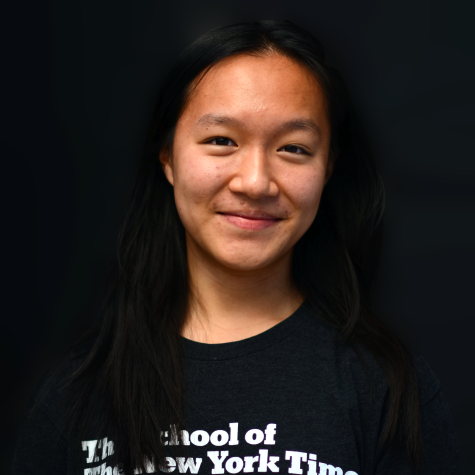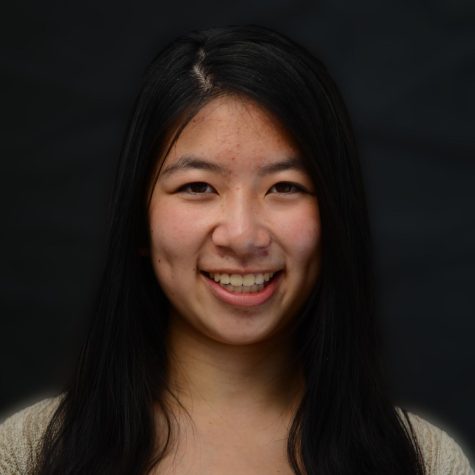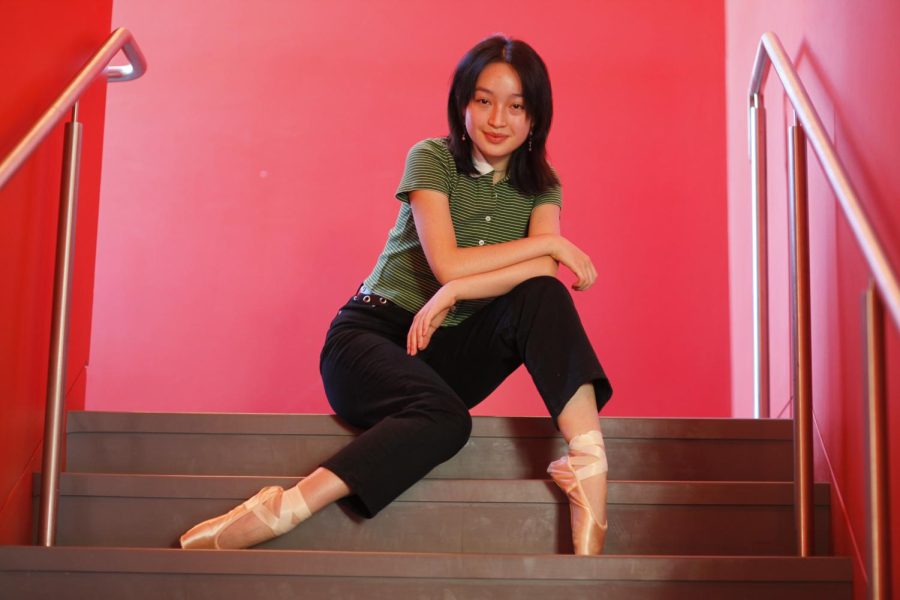Humans of Harker: Stage magic
With her own unique flair, Arely Sun inspires creative freedom in the arts
“For both theater and ballet, you have a set of guidelines: for dance, it’s choreography, and for theater, that’s your script. But in both, your role is to make those things feel like your own. You’re fully embodying the character and making it seem completely organic. You take your own interpretation of the piece and make small artistic decisions to make it fully what you feel is true to the character or the idea you’re trying to convey,” Arely Sun (’22) said.
Arely Sun (‘22) vividly recalls her 2020 performance at the Youth America Grand Prix competition in San Francisco. Dressed in simple brown and beige as the titular character in the ballet “Giselle,” it was her second time performing the act one variation, what had been her “dream variation” since she was a child.
A playful peek through the curtain, an elegant flair of the arms, and Arely begins, frolicking across the stage, flowing from a pas marche to a pirouette. She moves by muscle memory, letting exhilaration take over. From the toes of her pointe shoes to the tips of her fingers, everything felt in place, so much so that, with a whimsical air about her, Arely stays en pointe half a second longer. This was stage magic.
“What I like most about ballet is its rigid structure,” Arely said. “I tend to be kind of scatterbrained, so in a way, it forces me to try to strive for perfection and have a direction to work when I’m dancing in the studio. Because you have this structure, you get to play around with things within it, explore how you can do this movement the best way you can, how to make it fit your body, how you can add your own creative touches to some set choreography.”
Arely’s ballet journey started with mom-and-me lessons at a local studio at 4 years old. Although she has dabbled in other forms of dance as well, from contemporary to European folk, ballet has had the most influence over her mindset and lifestyle.
“Ballet is less about losing yourself and more about focus and attention,” Arely said. “It’s all about your own motivation. You have to look in the mirror and correct yourself and see how you can fix something, if you, for example, fall out of a pirouette. And putting that attention into improvement and seeing the results is a really gratifying feeling.”
Like almost all ballerinas, Arely once struggled with ballet’s notoriously rigorous and demanding nature. As a child, she had to learn to work around her turnout, or the rotation of the hips and feet. The competitiveness of the ballet community she grew up in also led to an unhealthy mindset of comparison.
After attending the two-week summer intensive camp at Ellison Ballet in New York, however, Arely adopted a new mindset of self-growth instead. Being the only participant in the camp who was not planning on pursuing ballet professionally, Arely describes that summer as a “turning point” in her relationship with ballet.
“Through that camp, I learned to focus on my own growth instead of comparing myself to others,” Arely said. “[I learned to] understand that it’s okay to not be the best, it’s okay to be a little lower than the average standard for the class because at the end of the day, ballet is about improving yourself and becoming a better performer and artist.”
Not only did ballet allow Arely to reflect on and better herself, but it also nurtured resilience in her, a quality that she carries into other aspects of her life.
“A big part of ballet [is] the teachers’ giving you corrections because they want to help you, not because you’re bad, but focusing on growth instead of what you’re doing wrong,” Arely said. “That’s something that I bring with me into other parts of my life: whenever I face setbacks, it’s always about like, ‘What can I do to improve and move on from here so I don’t make that same mistake again?’”
This mental grit is a quality that close friend Ysabel Chen (‘22) noticed almost immediately in Arely, when they met in sixth grade and worked together as debate partners.
“I remember [Arely’s] being very chill and relaxed about debate,” Ysabel said. “We kind of both sucked at it: the first tournament we went to, we lost all of the rounds, but I remember she didn’t care about losing [as much] as she did about having a good experience. That was my first impression of her, that she knows what’s important and when to have fun and things like that.”
Now, Arely’s drive helps her freely explore dance and ballet in a new way. After a brief hiatus from ballet in senior year, Arely found it difficult to resume the activity at the same level she had previously been at. Yet, this setback only motivated her further to not only relearn the technique but also rediscover her passion for dance.
“I lost a lot of the things that came easily to me as a kid, like having effortless extensions, things [I took] for granted before,” Arely said. “It felt like starting from ground zero again when I came back and I couldn’t do those things, but it actually gave me a chance to grow because I had to learn to do those things in a correct way and in a very technical way. It gave me a lot of satisfaction trying to get back to where I was before.”
This newfound appreciation for ballet sparked new interests in other dance forms for Arely. Although she doesn’t attend a formal studio now, she enjoys doing open classes and learning everything from hiphop to K-pop choreographies from YouTube tutorials.
Close friend and Aquila co-Editor-in-Chief Nicole Tian (‘22) notes Arely’s intrinsic curiosity, which she admired in Arely’s work as a managing editor of Aquila.
“Arely is very explorative,” Nicole said. “Arely doesn’t keep herself to, ‘I’m going to do this type of journalism all four years.’ In terms of journalism, she pursues what she’s interested in. I know she [worked] on a mental health package … she takes these issues that she’s passionate about and does something about them. She doesn’t restrict herself. She’s always open to learning more.”
The courage to explore, however, did not come easily to Arely at first. In fact, she used to find interviewing people scary, although it quickly became one of her favorite parts of the reporting process. She attributes her growth in self-confidence to journalism.
“I was really shy in ninth grade and quiet, scared to talk to people or speak up in class,” Arely said. “Journalism helped me become more outgoing. It helped me open up and learn to express my opinions, even if it means that other people might not agree, and then being able to have discussions based on that.”
Nicole noticed this change in Arely in the classroom, where Arely strove to voice her thoughts more.
“As a student, she pushes herself to contribute something,” Nicole said. “In our [AP Literature] class, Arely probably participated the most. She’s genuinely interested in the content and also she’s very respectful of her teachers.”
Another way Arely stepped outside of her comfort zone is through theater, which she began in sophomore year. Arely finds that theater allows for more creative freedom compared to ballet, but ultimately, the two art forms share the same charm that Arely adores in performance.
“For both theater and ballet, you have a set of guidelines: for dance, it’s choreography, and for theater, that’s your script,” Arely said. “But in both, your role is to make those things feel like your own. You’re fully embodying the character and making it seem completely organic. You take your own interpretation of the piece and make small artistic decisions to make it fully what you feel is true to the character or the idea you’re trying to convey.”

Erica Cai (12) is the co-editor-in-chief of Humans of Harker, and this is her fourth year on staff. Her goals in journalism this year are to celebrate...

Irene Yuan (12) is the co-managing editor of Harker Aquila with a focus on multimedia and social media. This is her fourth year on staff, and she hopes...


















![“[Building nerf blasters] became this outlet of creativity for me that hasn't been matched by anything else. The process [of] making a build complete to your desire is such a painstakingly difficult process, but I've had to learn from [the skills needed from] soldering to proper painting. There's so many different options for everything, if you think about it, it exists. The best part is [that] if it doesn't exist, you can build it yourself," Ishaan Parate said.](https://harkeraquila.com/wp-content/uploads/2022/08/DSC_8149-900x604.jpg)




![“When I came into high school, I was ready to be a follower. But DECA was a game changer for me. It helped me overcome my fear of public speaking, and it's played such a major role in who I've become today. To be able to successfully lead a chapter of 150 students, an officer team and be one of the upperclassmen I once really admired is something I'm [really] proud of,” Anvitha Tummala ('21) said.](https://harkeraquila.com/wp-content/uploads/2021/07/Screen-Shot-2021-07-25-at-9.50.05-AM-900x594.png)







![“I think getting up in the morning and having a sense of purpose [is exciting]. I think without a certain amount of drive, life is kind of obsolete and mundane, and I think having that every single day is what makes each day unique and kind of makes life exciting,” Neymika Jain (12) said.](https://harkeraquila.com/wp-content/uploads/2017/06/Screen-Shot-2017-06-03-at-4.54.16-PM.png)








![“My slogan is ‘slow feet, don’t eat, and I’m hungry.’ You need to run fast to get where you are–you aren't going to get those championships if you aren't fast,” Angel Cervantes (12) said. “I want to do well in school on my tests and in track and win championships for my team. I live by that, [and] I can do that anywhere: in the classroom or on the field.”](https://harkeraquila.com/wp-content/uploads/2018/06/DSC5146-900x601.jpg)
![“[Volleyball has] taught me how to fall correctly, and another thing it taught is that you don’t have to be the best at something to be good at it. If you just hit the ball in a smart way, then it still scores points and you’re good at it. You could be a background player and still make a much bigger impact on the team than you would think,” Anya Gert (’20) said.](https://harkeraquila.com/wp-content/uploads/2020/06/AnnaGert_JinTuan_HoHPhotoEdited-600x900.jpeg)

![“I'm not nearly there yet, but [my confidence has] definitely been getting better since I was pretty shy and timid coming into Harker my freshman year. I know that there's a lot of people that are really confident in what they do, and I really admire them. Everyone's so driven and that has really pushed me to kind of try to find my own place in high school and be more confident,” Alyssa Huang (’20) said.](https://harkeraquila.com/wp-content/uploads/2020/06/AlyssaHuang_EmilyChen_HoHPhoto-900x749.jpeg)



